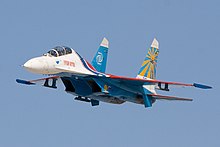Fixed-wing aircraft

Afixed-wing aircraftis a kind ofaircraft.An aircraft is amachinethat canfly,but is heavier thanair.Fixed-wing aircraft are sometimes calledairplanes,aeroplanesor sometimes just "planes". All fixed-wing aircraft havewingsthat useforward airspeedto generatelift.[1]Glidersare fixed-wing aircraft that do not haveengines.[2]
Fixed-wing aircraft fly between many cities all over the world, carrying people andcargo.Big cities usually have aninternationalairport,where large fixed-wingairlinersoperate.AirbusandBoeingare the two biggest makers of large airliners.
Statisticsshow that riding in a plane is safer than driving in a car.[3]
History[change|change source]
A steam-powered fixed-wingunmanned aerial vehiclethat weighed 9 lb (4.1 kg),[4]was built byJohn Stringfellow,inChard,Somerset,Englandin 1848. It could fly by itself without needing to be dropped from high up. There wereglidersbefore this, but they had to fly by being pushed off a building or hill.
The first man who flew (took off, steered, and landed) a motor-powered aircraft wasOrville Wrightin 1903 in Kitty Hawk, North Carolina,USA.[5]
Advances in technology have made fixed-wing aircraft more efficient. Things likewingletsand more efficientturbofanshave helped to do this.
Parts[change|change source]
Most fixed-wing aircraft have certain parts in common.
- Thewingsare the most important part because they are what makes the plane fly. Thewingscreate aforcecalled lift that goes against gravity which makes the plane get off the ground. When air flows around the wing (which happens when the plane moves forward) the wing pushes air down, which in turn pushes the plane up. Lift can also be explained usingBernoulli's principle;since wings are designed so that air goes faster on the top of the wing than on the bottom, the higher pressure on the bottom will push the plane up. Some wings have panels on the back called flaps. Flaps can be extended to make the wing bigger. This makes the wing make more lift, but also moredrag.This lets the plane fly slower withoutstalling,so flaps are often used during takeoff and landing.
- Thetail(also called thevertical stabilizer) is a large flat panel normally at the back of the plane. This helps the plane fly straight. Some planes have more than one tail, like theAntonov An-225.Some planes also have no tail, like theNorthrop Grumman B-2 Spirit.
- Enginespush the plane forward. This makes air flow over the wings, which makes the plane fly. Some planes havepropellersthat theengineturns. Others havejet engines.Some fixed-wing aircraft, such asgliders,don't have engines. Instead they use gravity to give them forward speed.
- Thefuselageis the part of the plane that holds the people andcargo.It is normally shaped like acylinder.Thefuselagemight have windows or doors.
- Thelanding gearorundercarriageis what supports the plane on the ground. It can be wheels if the plane lands on the ground, orfloatsif the plane lands in the water. If the plane lands in snow, the landing gear usually hasskis.Many planes can retract (bring inside the fuselage) their landing gear to make lessdrag.
Uses[change|change source]
Transport[change|change source]
Fixed-wing aircraft have long been used asairliners for movingpassengers from place to place.Cargo aircraftcarrycargoacross seas and long distances, and passenger aircraft also carry some cargo.
War[change|change source]

The first aircraft for war bombing was used inLibyain 1911 byItalyagainst theOttoman Empire.Some fixed-wing aircraft are used byair forcestodefendcountries. These may befighter aircraft,usinggunsormissilesfor combat with other aircraft. They may bebombers,droppingbombson ground targets.
Fixed-wing aircraft allow people to travel longer distances, and faster thanshipsortrains.Aircraft can fly from New York to London in about 7 hours. It would take one week or more on a ship. Militaries use airplanes to carry their soldiers quickly from place to place.
Airplanes are also used by the military to see many things on the ground easily. This is calledsurveillanceorreconnaissance.Often, fixed-wing aircraft will takephotographsas well, which can be used for military planning later.
Image gallery[change|change source]
-
Military airplanes inRussia
-
An airplane used for research byNASA
-
Early airplanes in a battle inFrance
-
A private airplane
References[change|change source]
- ↑David Anderson; Scott Eberhardt."How Airplanes Fly: A Physical Description of Lift".The Aviation History Online Museum.Retrieved26 March2016.
{{cite web}}:CS1 maint: multiple names: authors list (link) - ↑Susan Meredith,How Do Aircraft Fly?(New York, NY: Chelsea Clubhouse, 2010), p. 18
- ↑Flying still safer than driving, even in wake of Sept. 11[permanent dead link]
- ↑High hopes for replica plane, BBC News
- ↑"Telegram from Orville Wright in Kitty Hawk, North Carolina, to His Father Announcing Four Successful Flights, 1903 December 17".World Digital Library.1903-12-17.Retrieved2013-07-21.




